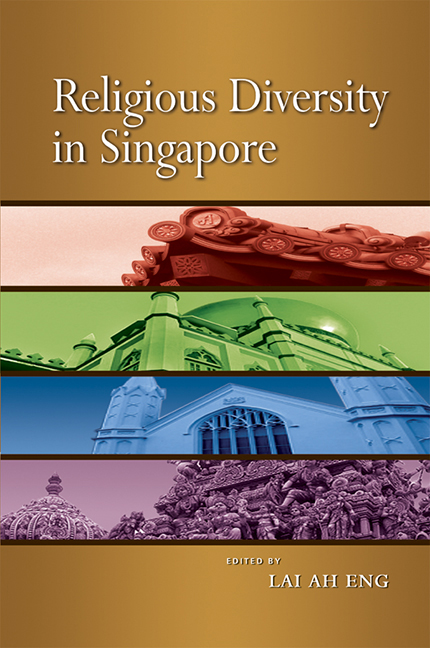Book contents
- Frontmatter
- Contents
- List of Figures and Tables
- List of Appendices
- FOREWORD
- PREFACE
- Acknowledgements
- The Contributors
- Abbreviations
- Glossary
- INTRODUCTION
- PART I The Landscape of Religious Diversity
- 1 Religious Influences and Impulses Impacting Singapore
- 2 Religious Trends and Issues in Singapore
- 3 Keeping God in Place: The Management of Religion in Singapore
- 4 Discourses on Islam in Southeast Asia and Their Impact on the Singapore Muslim Public
- 5 Global Christian Culture and the Antioch of Asia
- 6 “Religiously-inspired”, “India-derived” Movements in Singapore
- 7 Baha'is in Singapore: Patterns of Conversion
- 8 Diversities and Unities: Towards a Reformist Buddhism in Singapore
- 9 The Sathya Sai Baba Movement in Singapore: Its Service Mission and Philosophy of Communal Identity Construction
- 10 The Muslim Religious Elite of Singapore
- 11 The Evolution of the Sikh Identity in Singapore
- 12 Religious Processions: Urban Politics and Poetics
- PART II Religion in Schools and Among the Young
- PART III Religion in the Media
- PART IV Religious Organizations in Social Services
- PART V Interfaith Issues and Interaction
- Index
12 - Religious Processions: Urban Politics and Poetics
from PART I - The Landscape of Religious Diversity
Published online by Cambridge University Press: 21 October 2015
- Frontmatter
- Contents
- List of Figures and Tables
- List of Appendices
- FOREWORD
- PREFACE
- Acknowledgements
- The Contributors
- Abbreviations
- Glossary
- INTRODUCTION
- PART I The Landscape of Religious Diversity
- 1 Religious Influences and Impulses Impacting Singapore
- 2 Religious Trends and Issues in Singapore
- 3 Keeping God in Place: The Management of Religion in Singapore
- 4 Discourses on Islam in Southeast Asia and Their Impact on the Singapore Muslim Public
- 5 Global Christian Culture and the Antioch of Asia
- 6 “Religiously-inspired”, “India-derived” Movements in Singapore
- 7 Baha'is in Singapore: Patterns of Conversion
- 8 Diversities and Unities: Towards a Reformist Buddhism in Singapore
- 9 The Sathya Sai Baba Movement in Singapore: Its Service Mission and Philosophy of Communal Identity Construction
- 10 The Muslim Religious Elite of Singapore
- 11 The Evolution of the Sikh Identity in Singapore
- 12 Religious Processions: Urban Politics and Poetics
- PART II Religion in Schools and Among the Young
- PART III Religion in the Media
- PART IV Religious Organizations in Social Services
- PART V Interfaith Issues and Interaction
- Index
Summary
INTRODUCTION
Processions have traditionally been an integral part of religious life. They are often among the most visible of religious activities in public spaces and, to that extent, have the greatest opportunity for contact with secular activities and religious practices of other faiths. Because they tend towards the “spectacular” and symbolic, the potential for conflict is heightened. As events which attract crowds, the possibility of violence and aggression is real, as the experience in many countries reminds us. The politics of such events must be understood to avoid the troubles apparent in different parts of the world. At the same time, to understand the politics of processions, it is imperative to understand the meanings and values invested in such events — in short, the poetics — not least because it enables policy-makers and enforcement agencies to become aware of what sacred meanings are negotiable and what should remain fixed values.
Much of the geographical literature on processions addresses secular processions, including national parades (Kong and Yeoh 1997), and community parades such as the Carnival in London (Jackson 1988; Lewis and Pile 1996), the Rose Parade and the Doo Dah Parade in Pasadena, California (Lawrence 1982). The literature which is closest to the subject matter on religious processions deals with pilgrimages (see Kong 1990, 2001). Indeed, there are many similarities between the nature and experience of processions and pilgrimages, though the latter is at a larger scale, often traversing greater distances, involving greater commitment of time and possibly enduring more privations. Insights drawn from existing literatures therefore, are from the literature on both secular processions and religious pilgrimages.
How has modern society and its many secular influences impacted on the practice of processions? Campo (1998, p. 42) forcefully argues that
… the modern nation-state, the world capitalist system, steel, plastic, the telephone, the locomotive, the automobile, the airplane, the television, and — yes — the computer are making it possible for greater numbers of people in more cultures to learn about, travel to, and see more sacred places faster than at any other time in human history. A significant result of this has been that the number and variety of sacred places have also increased dramatically.
- Type
- Chapter
- Information
- Religious Diversity in Singapore , pp. 298 - 318Publisher: ISEAS–Yusof Ishak InstitutePrint publication year: 2008



